TC
Auto Added by WPeMatico
Auto Added by WPeMatico
Reelgood, a startup aimed at helping cord cutters find their next binge, is out today with its biggest update yet. The company has been developing its streaming guide over the past year to solve the issues around discovery that exist when consumers drop traditional pay TV in favor of streaming services like Netflix, Hulu, HBO, Prime Video, and others.
The company first launched as a website in the summer of 2017 before expanding to mobile last fall. During that time, it’s grown to over a million monthly active users who now check in with Reelgood to find something new to watch.
With today’s update to its iOS app, Reelgood is adding a number of features, including personalized recommendations, curated selections, alerts for shows and movies you’re tracking, advanced search and filtering, and the ability to track content over 50 more streaming services, among other things.
As discovery is Reelgood’s focus, the updated app now offers two new types of recommendations.
One is Reelgood’s own take on “Because You Watched” – a type of viewing suggestion you’ll find today on individual services, like Netflix. But those are more limited because they’ll only suggest other shows or movies they offer themselves. Reelgood’s recommendations will instead span all the services you have access to, offering a more universal set of suggestions.
This feature is tied to Reelgood’s watch history, where you track which shows and movies you’ve seen. That means you have to use Reelgood as your tracking app as well, in order for this feature to work.
The app’s other new way of offering recommendations is less personalized – in fact, it’s random. Because sometimes serendipity is a better way to find something, a feature called “Reelgood Roulette” lets you shake your device while on the Discover tab to get a non-personalized, random suggestion.
Reelgood credits Netflix Roulette, created by Andrew Sampson, as the basis for this addition. In fact, it acquired the rights to the software last year, and then updated it to support more streaming services.
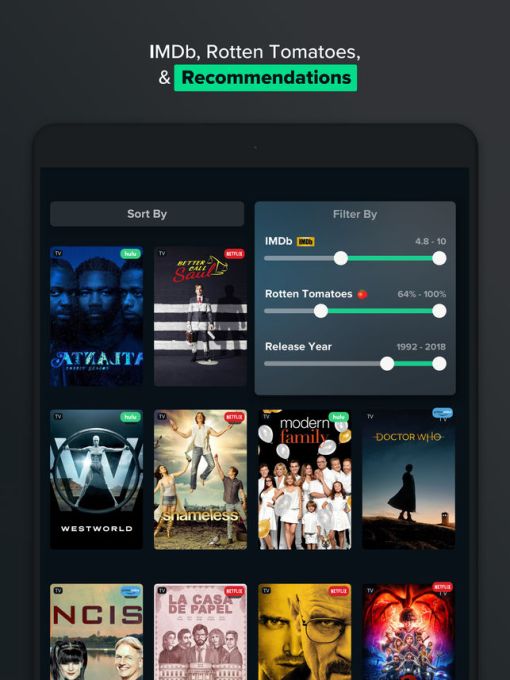
The app also now offers more powerful search and filtering capabilities involving Rotten Tomatoes, IMDb scores, plus cast and crew listings. This allows you to query up things like “Meryl Streep’s top-rated movies” or “drama series with an IMDb rating of at least 8.0 that came out in the last 3 years,” for example.
Reelgood’s search and filtering mechanisms have always been the place where it excels, but it’s less useful as a simple tracker. For that, I prefer TV Time, which lets you quickly mark entire seasons or series as “Watched” and offers discussion boards for each episode where you can post photos and memes and chat with other fans.
TV Time, however, hasn’t been as useful for making recommendations – its suggestions have been off-the-mark when I’ve tried it in the past, often leaning too heavily on network’s back catalogs than pushing me to more current or trending content. It makes me wish I could combine the two apps into one for the best of both worlds – tracking and recommendations.
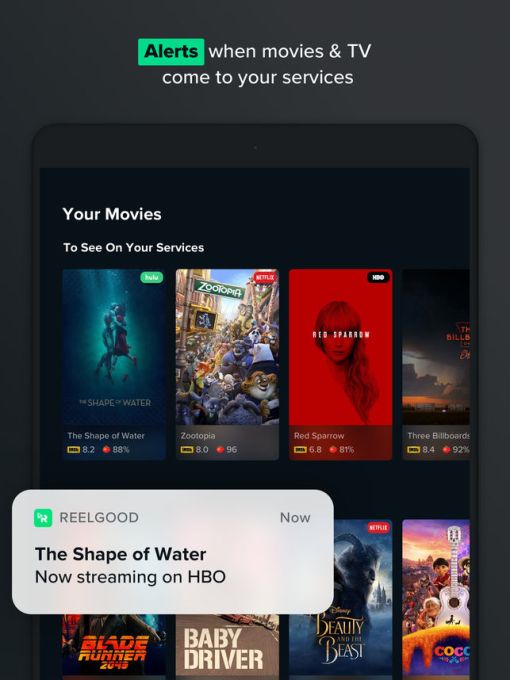
The updated Reelgood app also doubles down on its own curation capabilities by offering editorial collections. For example: 2018 Emmy Nominees, IMDb’s Top 250 Movies, Original Picks, Dark Comedies, British Humour, and more. This can be a good way to find something to watch when you’re really stumped.
And as you discover new shows and movies you want to see, you can set alerts so you’ll be notified when they hit one of the streaming services you’re subscribed to, similar the tracking feature on Roku OS.
Finally, Reelgood’s update includes the addition of 50+ streaming services – that means there’s now support for more niche services like IndieFlix, FilmStruck, Shudder, Fandor, Crunchyroll, Mubi, AcornTV and Starz, among others.
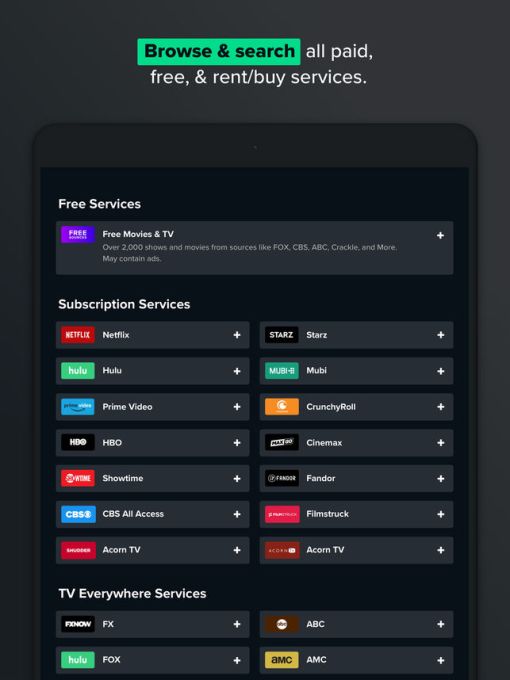
“Reelgood 4.0 is the culmination of all we’ve learned about how people watch and the increasingly fragmented streaming world,” said Eli Chamberlin, Reelgood’s head of product and design. “Our aim with this release was to take all the streaming content out there, and display it in the most meaningful way possible so that people can get the most out of their existing streaming services without wasting countless hours browsing.”
The new app is rolling out to iOS today on the App Store.
Powered by WPeMatico
Longtime venture capitalist Shirish Sathaye has quietly joined early-stage investor Cervin Ventures as a general partner.
Most recently, Sathaye was a general partner at Formation 8, the embattled venture firm co-founded by Palantir’s Joe Lonsdale, Brian Koo (a scion of the Koo family, owners of the electronics giant LG) and former Khosla GP Jim Kim. Formation 8 announced in 2015 that it would not raise a third fund and would begin winding down operations.
Sathaye, who’s been in the VC business since 2001 as a GP at Matrix Partners, then at Khosla Ventures, remains a partner in Formation 8’s sophomore fund. His previous investments include Nutanix, Samsung-acquired Grandis, McAfee-acquired Solidcore Systems, cybersecurity startup Vectra Networks and data storage provider Panzura.
He’d only been at Formation 8 for one year when the firm began to crumble. As we now know, conflict between the firm’s founding partners led to its demise. Lonsdale quickly raised $425 million for a spin-off fund called 8VC; Koo, in a similar fashion, brought in $357 million for Formation Group and Kim followed up with a $200 million fund called Builders.
Sathaye, for his part, had grown tired of the “bigger is better” mentality and opted to leave the business of big VC for good.
He began making angel investments and advising startups at Cervin Ventures, a pre-Series A VC fund focused on the enterprise. It closed a $56 million fund in 2017, its largest vehicle to date.
“Smaller funds, in general, make better decisions,” Sathaye told TechCrunch. “At a larger fund, there are more people around the table to make decisions. I think returns are better when there are fewer people making those decisions.”
Watching funds swell past the billion-dollar mark and investors deploy the “spray and pray” strategy was a turn-off, Sathaye said. Startups have more access to capital than ever before, yet most companies can get off the ground with very little funding, thanks to recent innovations like Google Cloud and Amazon Web Services.
“With AWS, companies can bring products to market quickly and they can reach their customers with much less money,” Sathaye said. “If you look at it just from a returns profile, the smaller funds will get better cash-on-cash returns simply because companies don’t need that much money to be successful.”
Palo Alto-based Cervin is led by two other GPs, Preetish Nijhawan and Neeraj Gupta. It invests $1 million to $2 million in early-stage startups. Sathaye says he’ll be focused specifically on the security, mobile, cloud and data verticals.
Powered by WPeMatico

Photographer: Daro Sulakauri/Bloomberg
According to a new study conducted by the Center for American Entrepreneurship and NYU’s Shack Institute of Real Estate, the US may be losing its competitive advantage as the dominant nucleus of the startup and venture capital universe.
The analysis, led by senior Brookings Institution fellow Ian Hathaway and “Rise of the Creative Class” author Richard Florida, examines the flow of venture capital over 100,000 deals from 2005 to 2017 and details how the historically US-centric practice of venture capital has become a global phenomenon.
While the US still appears to produce the largest amount of venture activity in the world, America’s share of the global pie is falling dramatically and doing so quickly.
In the mid-90s, the US accounted for more than 95% of global venture capital investment. By 2012, this number had fallen to 70%. At the end of 2017, the US share of total venture investment had fallen to just 50%.
Over the last decade, non-US countries have propelled growth in the global startup and venture economy, which has swelled from $50 billion to over $170 billion in size. In particular, China, India and the UK now account for a third of global venture deal count and dollars – 2-3x the share held ten years ago. And with VC dollars increasingly circulating into modernizing Asia-Pac and European cities, the researchers found that the erosion in the US share of venture capital is trending in the wrong direction.
We’ve spent the summer discussing the notion of Silicon Valley reaching its parabolic peak – Observing the “rise of the rest” across smaller American tech hubs. In reality, the data reveals a “rise in the rest of the world”, with startup ecosystems outside the US growing at a faster pace than most US hubs.
The Bay Area remains the world’s preeminent beneficiary of VC investment, and New York, Los Angeles, and Boston all find themselves in the top ten cities contributing to global venture growth. However, only six of the top 20 cities are located in the US, while 14 are in Asia or Europe. At the individual level, only two American cities crack the top 20 fastest growing startup hubs.
Still, the authors found the bulk of VC activity remains highly concentrated in a small number of incumbent startup cities. More than 50% of all global venture capital deployed can be attributed to only six cities and half of the growth in VC activity over the last five years can be attributed to just four cities. Despite the growing number of ecosystems playing a role in venture decisions, the dominant incumbent startup hubs hold a firm grip on the majority of capital deployed.
Unsurprisingly, the largest contributor to the globalization of venture capital and the slimming share of the US is the rapid escalation of China’s startup ecosystem.
In the last three years, China has captured nearly a fourth of total VC investment. Since 2010, Beijing contributed more to VC deployment growth than any other city, while three other Chinese cities (Shanghai, Hangzhou, Shenzhen) fell in the top 15.
A major part of China’s ascension can be tied to the idiosyncratic rise of late-stage “mega deals”, which the study defines as $500 million or more in size. Once an extremely rare occurrence, mega deals now make up a significant portion of all venture dollars deployed. From 2005-2007, only two mega deals took place. From 2010-2012, eight of such deals took place. From 2015-2017, there were 80 global mega deals, representing a fifth of the total venture capital activity. Chinese cities accounted for half of all mega deal investment over the same period.
It’s not all bad for the US, with the study highlighting continued ecosystem growth in established US hubs and leading roles for non-valley markets in NY, LA, and Boston.
And the globalization of the startup and venture economy is by no means a “bad thing”. In fact, access to capital, the spread of entrepreneurial spirit, and stronger global economic development and prosperity is almost unquestionably a “good thing.”
However, the US’ share of venture-backed startups is falling, and the US losing its competitive advantage in the startup and venture capital market could have major implications for its future as a global economic leader. Five of the six largest US companies were previously venture-backed startups and now provide a combined value of around $4 trillion.
The intense competition for talent marks another major challenge for the US who has historically been a huge beneficiary of foreign-born entrepreneurs. With the rise of local ecosystems across the globe, entrepreneurs no longer have to flock to the US to build their companies or have access to venture capital. The problem attracting entrepreneurs is compounded by notoriously unfriendly US visa policies – not to mention recent harsh rhetoric and tension over immigration that make the US a less attractive destination for skilled immigrants.
At a recent speaking event, Florida stated he believed the US’ fading competitive advantage was a greater threat to American economic power than previous collapses seen in the steel and auto industries. A sentiment echoed by Techstars co-founder Brad Feld, who in the report’s forward states, “government leaders should read this report with alarm.”
It remains to be seen whether the train has left the station or if the US can hold on to its position as the world’s venture leader. What is clear is that Silicon Valley is no longer the center of the universe and the geography of the startup and venture capital world is changing.
“The Rise of the Global Startup City: The New Map of Entrepreneurship and Venture Capital” tries to illustrate these tectonic shifts and identifies tiers of global startup cities based on size, growth and balance of VC deals and investments.
Powered by WPeMatico
Magic Leap has announced they are acquiring Computes, a decentralized mesh computing startup. Terms of the deal weren’t disclosed.
From Magic Leap’s blog post:
From the beginning, Chris Matthieu and Jade Meskill started Computes, Inc. based on the principle of enabling the next generation of computing. We believe Magic Leap is the perfect home to achieve this vision
Why would Magic Leap want to get their hands on this company? Well, it’s no secret that building a “digital layer” on top of the real world is more than a little compute-heavy; mesh computing offers an attractive future for leveraging the power of grouped systems to push resources to the devices that need it most.
The company’s website does a not-so-great job of explaining what exactly they do, but here’s a blip from one of the company’s whitepapers:
The Lattice protocol allows authorized computers to self-organize into a mesh computer, limited only by the number and power of the members. Lattice will intelligently allocate work to the best members of the mesh, based on the requirements of the task.
This is an interesting idea for AR headset systems, where eventually most of them may be in standby on average and could theoretically push their compute power to another system. Perhaps more likely is offsite PCs with beefy internals offering the headsets a punch. On the far less sexy side, this could also just be a play for the startup to drill down some of its backend services.
If you’re still curious about what they do and are interested in some even more mildly dubious explaining, check out this video from Computes’ CEO, which only mildly resembles a video from the Dharma Initiative.
Powered by WPeMatico
When Amazon rolled out its membership-based two-day shipping service in 2005, e-commerce and customer expectations around fulfillment speed changed forever.
Today, more than 100 million people use Amazon Prime. That means, 100 million people are fully accustomed to two-day shipping and if they can’t have it, they shop elsewhere. As The Wall Street Journal’s Christopher Mims recently put it: “Alongside life, liberty and the pursuit of happiness, you can now add another inalienable right: two-day shipping on practically everything.”
Only recently have Amazon’s competitors begun to offer similar fast delivery options. About two years ago, Walmart launched its own free two-day delivery service for its owned-inventory; eBay followed suit, establishing a three-day or less delivery guaranteed option for shoppers in March 2017.
To power these Prime-like delivery options, Walmart, eBay and the Canadian e-commerce business Shopify are relying on a little upstart.
One-year-old Deliverr helps businesses offer rapid delivery experiences to their customers. Today, the company is announcing a $7.1 million Series A led by Joe Lonsdale’s 8VC, with participation from Zola founder Shan-Lyn Ma, Flexport chief executive officer Ryan Peterson and others.
The San Francisco-based startup uses machine learning and predictive intelligence to determine which of its warehouses to store its client’s goods.
Currently, Deliverr operates out of more than 10 warehouses in Texas, Missouri, Pennsylvania, Ohio and New Jersey, among other states, though co-founder Michael Krakaris says that number is growing every week. Its customers typically store inventory in three to five different locations based on Deliverr’s predictive algorithms.
Unlike Amazon, which owns more than 75 fulfillment centers, Deliverr doesn’t own its warehouses. Krakaris describes the company’s strategy as a sort of Uber for fulfillment.
“Uber didn’t change the physical infrastructure of cars. They didn’t build their own taxis. What they did was create software that could connect excess capacity drivers,” Krakaris told TechCrunch. “Most warehouses aren’t going to be full. We are going in and filling that extra space they wouldn’t otherwise fill.”
One of the startup’s tricks is to use brand-neutral packaging so any and all marketplaces could theoretically power fulfillment through Deliverr. Amazon, of course, sticks a Prime sticker on all its outgoing packages. And because Amazon’s fulfillment service is used by some eBay sellers, eBay items are known to show up at customers’ homes in Amazon-branded packaging. Not a great look for eBay.
“You need an independent fulfillment service that can handle all these different fulfillment channels and be neutral,” Krakaris said.
Deliverr plans to use the investment to scale its team and ink partnerships with additional online retailers.
Powered by WPeMatico
Forward Health, the U.K. startup that has built an app to help healthcare professionals communicate in a secure and compliant way, has picked up $3.9 million in seed funding.
Leading the round is Stride.VC, the new VC fund from Fred Destin, formerly a partner at Accel, and Harry Stebbings, producer of the “The Twenty Minute VC” and most recently Entrepreneur-in-Residence at VC firm Atomico.
Additional backing comes from Albion Capital, while Forward already boasts a decent array of angel investors. They include healthtech founders Jay Desai from U.S. company Patient Ping, and Melissa Morris from U.K.-based Lantum.
 Founded in 2016 by U.K. doctors Barney Gilbert and Lydia Yarlott, with serial entrepreneur Philip Mundy (who previously founded Goodlord), Forward Health is a messaging app and broader communications platform designed for healthcare professionals, particularly those working in hospitals.
Founded in 2016 by U.K. doctors Barney Gilbert and Lydia Yarlott, with serial entrepreneur Philip Mundy (who previously founded Goodlord), Forward Health is a messaging app and broader communications platform designed for healthcare professionals, particularly those working in hospitals.
One overly simple way to think of it is as a “WhatsApp for doctors,” helping to wean healthcare professionals off of using the popular messaging app professionally, which is entirely unsuited for a regulated industry like healthcare. However, the bigger vision is to “connect healthcare systems around the world” by improving clinician-to-clinician (and potentially clinician-to-patient) communication and information-sharing with a platform that is built from the get-go to be secure, flexible and compliant.
“Healthcare communication is incredibly fragmented,” Forward Healthcare’s Mundy tells me. “This has a direct impact on how well clinicians can do their jobs and the level of care patients receive. Currently, doctors and nurses working within the NHS have to rely on an outdated and inefficient combination of pagers, landlines, switchboards and fax machines to contact each other. This 1960s infrastructure wastes huge amounts of time and can lead to critical delays in information flow.”
It is in this context that clinicians have resorted to alternative methods of communication, such as WhatsApp, which Mundy rightfully says are not fit for purpose and pose real risks.
“Any communication of this kind needs to support the exchange of highly sensitive patient information, any app used needs to be NHS digital compliant, GDPR compliant and operate within the highest levels of data security,” he explains. “WhatsApp and others don’t do this, meaning individual doctors could be liable should patient data be sent to the wrong contact or thread. Additionally, an app such as Forward is designed by and for doctors, meaning it can perform in just the right way.”
In Forward’s case, that means offering an in-app directory of healthcare professionals who work within the same hospital so that it is possible to message colleagues even if you don’t know their number, “safe exchange of information and images,” the ability to create task lists and a way of ensuring everyone involved with a patient’s care “is on the same page and working from the same information.” The latter includes the ability for clinicians to share patient cards, akin to a mini electronic health record, on a need-to-know basis.
To that end, the Forward app is GDPR compliant, NHS IG Toolkit Certified and meets the GMC’s confidentiality guidelines. Clinicians must have an approved NHS or Trust email address to log into the app. Over the last year it has been piloted with a community of 5,000 doctors across five partner hospitals.
In a call with Harry Stebbings — who led the round on behalf of Stride and whom I promised not to refer to as a podcaster-turned-VC (sorry, Harry, I’m a terrible person!) — he told me that Forward Health’s mission resonated with him personally due to his first-hand experience of how doctors communicate and share information in the NHS. It is quite well-known that Stebbings’ mother has MS, while more recently his father suffered a heart attack.
“I knew healthcare communication was broken when, post my father’s heart attack, they faxed his ECG scans,” he says, aghast.
When he was introduced to the Forward Health team, Stebbings says he already understood the problem. But, more so, he looks for founder-market fit and believes the Forward founders are extremely well-placed to solve this particular problem, with the right mixture of healthcare and product backgrounds.
He says that another thing that has impressed him is the bottom-up growth that the Forward app has garnered, which we both agree is a little reminiscent to how business social network Yammer originally penetrated corporations. This sees healthcare professionals download the app and sign up using their NHS email address, without the need for a central diktat. They then typically encourage colleagues to do the same, which creates further network effects. This viral growth is also benefiting from the current career path of junior doctors, who, as part of their training, move from hospital to hospital and in turn spread use of the Forward app.
Adds Mundy: “The last year has not only furthered our aims to help thousands of doctors and nurses avoid using pagers and WhatsApp, but it’s also shown us the scale of the clinical communication problem. It’s an issue at every level of healthcare, from A&E to community services, and affects all clinicians and every patient. With this capital, we’ll be able to work with even more clinicians across the U.K. to identify their challenges and expand our product to help solve them. We believe our current offering is just the start of what our platform is set to become.”
Powered by WPeMatico
Adults, not teens. Messaging, not Stories. Developing markets, not the U.S. These are how Snapchat will make a comeback, according to CEO Evan Spiegel . In a 6,000-word internal memo from late September leaked to Cheddar’s Alex Heath, Spiegel attempts to revive employee morale with philosophy, tactics and contrition as Snap’s share price sinks to an all-time low of around $8 — half its IPO price and a third of its peak.
“The biggest mistake we made with our redesign was compromising our core product value of being the fastest way to communicate,” Spiegel stresses throughout the memo regarding “Project Cheetah.” It’s the chat that made Snapchat special, and burying it within a combined feed with Stories and failing to build a quick-loading Android app have had disastrous consequences.

Spiegel shows great maturity here, admitting to impatient strategic moves and outlining a cohesive path forward. There’s no talk of Snapchat ruling the social app world here. He seems to understand that’s likely out of reach in the face of Instagram’s competitive onslaught. Instead, Snapchat is satisfied if it can help us express ourselves while finally reaching even meager profitability.
Snapchat may be too perceived as a toy to win enough adults, too late to win back international markets from the Facebook empire and too copyable by good-enough alternatives to grow truly massive. But if Snap can follow the Spiegel game plan, it could carve out a sustainable market through a small but loyal audience who want to communicate through imagery.
Here are the most interesting takeaways from the memo — and why they’re important:
There were, of course, some downsides to moving as quickly as a cheetah We rushed our redesign, solving one problem but creating many others . . . Unfortunately, we didn’t give ourselves enough time to continue iterating and testing the redesign with a smaller percentage of our community. As a result, we had to continue our iterations after we launched, causing a lot of frustration for our community.
Spiegel always went on his gut rather than relying on user data like Facebook. Aging further and further away from his core audience, he misread what teens cared about. The appealing buzz phrase of “separating social from media” also meant merging messaging and Stories into a chaotic list that made both tougher to use. Spiegel seems to have learned a valuable lesson about the importance of A/B testing.

Our redesigned algorithmic Friend Feed made it harder to find the right people to talk to, and moving too quickly meant that we didn’t have time to optimize the Friend Feed for fast performance. We slowed down our product and eroded our core product value. . . . Regrettably, we didn’t understand at the time that the biggest problem with our redesign wasn’t the frustration from influencers – it was the frustration from members of our community who felt like it was harder to communicate . . . In our excitement to innovate and bring many new products into the world, we have lost the core of what made Snapchat the fastest way to communicate.
When Snap first revealed the changes, we predicted that “Teen Snap addicts might complain that the redesign is confusing, jumbling all content from friends together.” That made it too annoying to dig out your friends to send them messages, and Snap’s growth rate imploded, with it losing 3 million users last quarter. Expect Snap to optimize its engineering to make messages quicker to send and receive, and even sacrifice some of its bells and whistles to make chat faster in developing markets.
Your top friend in a given week contributes 25% of Snap send volume. By the time you get to 18 friends, each incremental friend contributes less than 1% of total Snap send volume each. Finding best friends is a different problem than finding more friends, so we need to think about new ways to help people find the friends they care most about.
Facebook’s biggest structural disadvantage is its broad friend graph that’s bloated to include family, co-workers, bosses and distant acquaintances. That might be fine in a feed app, but not for Stories and messaging where you only care about your closest friends. With friend lists and more, Facebook has tried and failed for a decade to find better ways to communicate with your besties. This is the wedge through which Snapchat can attack Facebook. If it develops special features for luring your best friends onto the app and staying in touch with them for better reasons than just maintaining a Snap “Streak,” it could hit Facebook where it can’t defend itself.

Our Shows continue to attract more and more viewers, with over 18 Shows reaching monthly audiences of over 10M unique viewers. 12 of which are Original productions. As a platform overall, we’ve grown the amount of total time spent engaging with our Shows product, almost tripling since the beginning of the year. Our audience for Publisher Stories has increased over 20% YoY, and we believe there is a significant opportunity to continue growing the number of people who engage with Discover content . . .We are also working to identify content that is performing well outside of Snapchat so that we can bring it into Discover.
Discover remains Snapchat’s biggest differentiator, scoring with premium video content purposefully made for mobile. What it really needs, though, are a few must-see tent-pole shows to drag in a wider audience that can get hooked on the reimagined digital magazine experience.
Our content team is working hard to experiment with new layouts and content types in the wake of our redesign to drive increased engagement.
Snapchat Discover is an overcrowded pile of clickbait. News outlets, social media influencers, original video Shows and aggregated user content collections all battle for attention in a design that feels overwhelming to the point of exhaustion. Thankfully, Snapchat seems to recognize that more cohesive sorting with fewer images and headlines bombarding you might make Discover a more pleasant lean-back consumption experience.

Most of the incremental growth in our core markets like the US, UK, and France will have to come from older users who generate higher average revenue per user . . . Growing in older demographics will require us to mature our application . . . Many older users today see Snapchat as frivolous or a waste of time because they think Snapchat is social media rather than a faster way to communicate. Changing the design language of our product and improving our marketing and communications around Snapchat will help users understand our value . . . aging-up our community in core markets will also help the media, advertisers, and Wall Street understand Snapchat.
Snapchat can’t just be for cool kids anymore. Their lower buying power and life stage make them less appealing to brands. The problem is that Snapchat risks turning off younger users by courting their older siblings or adults. If, like Facebook, users start to feel like Snapchat is a place for parents, they may defect in search of the next purposefully built app to confuse adults to stay hip.
We already have many projects underway to unlock our core product value in new markets. Mushroom allows our community to use Snapchat on lower-end devices. Arroyo, our new gateway architecture, will speed up messaging and many other services . . . It might require us to change our products for different markets where some of our value-add features detract from our core product value.
Sources tell me Snapchat’s future depends on the engineering overhaul of its Android app, a project codenamed “Mushroom.” Slow video load times and bugs have made Snapchat practically unusable on low-bandwidth connections and old Android phones in the developing world. The company concentrated on the U.S. and other first-world markets, leaving the door open for copycats of Stories built by Instagram (400 million daily users) and WhatsApp (450 million daily users) to invade the developing world and dwarf Snap’s 188 million total daily users. In hopes of a smooth rollout, Snapchat is already testing Mushroom, but it will have to do a ton of marketing outreach to convince frustrated users who ditched the app to give it another try.

We’re currently building software that takes the millions of Snaps submitted to Our Story and reconstructs parts of the world in 3D. We can then build augmented reality experiences on top of those models and distribute them as Lenses . . . If our innovation compromises our core product of being the fastest way to communicate, we should consider create [sic] separate applications or other ways of delivering our innovation.
Snapchat has big plans for augmented reality. It doesn’t just want to stick animations over the top of anywhere, or create AR art installations in a few big cities. It wants to build site-specific AR experiences across the globe. And while everything the company has built to date has lived inside of Snapchat, it’s willing to spawn standalone apps if necessary so that it doesn’t bog down its messaging service. That could give Snapchat a lot more leeway to experiment.
Our 2019 stretch output goal will be an acceleration in revenue growth and full year free cash flow and profitability. With profitability comes increased autonomy and freedom to operate our business in the long term best interest of our community without the pressure of needing to raise additional capital.
Snapchat is still bleeding money, losing $353 million last quarter. Snapchat ended up selling 2.3 percent of its equity to a Saudi Arabian prince in exchange for $250 million to lengthen its rapidly shortening runway. And last year it took $2 billion from Chinese gaming giant Tencent. Deals like that could threaten Snapchat’s ability to prioritize its goals alone, not the moral imperatives or developer platforms that would benefit its benefactors. Once profitable, Snapchat won’t have to worry so much about struggling with short-term user growth and can instead focus on retention, societal impact and its true purpose — creativity.

Powered by WPeMatico
This is sure to exacerbate fears that Facebook will further exploit Instagram now that its founders have resigned. Instagram has been spotted prototyping a new privacy setting that would allow it to share your location history with Facebook. That means your exact GPS coordinates collected by Instagram, even when you’re not using the app, would help Facebook to target you with ads and recommend you relevant content. Worryingly, the Location History sharing setting was defaulted to On in the prototype. The geo-tagged data would appear to users in their Facebook Profile’s Activity Log, which include creepy daily maps of the places you been.
This commingling of data could upset users who want to limit Facebook’s surveillance of their lives. With Facebook installing its former VP of News Feed and close friend of Mark Zuckerberg, Adam Mosseri, as the head of Instagram, some critics have worried that Facebook would attempt to squeeze more value out of Instagram. Tat includes driving referral traffic to the main app via spammy notifications, inserting additional ads, or pulling in more data. Facebook was sued for breaking its promise to European regulators that it would not commingle WhatsApp and Facebook data, leading to an $122 million fine.

A Facebook spokesperson tells TechCrunch that “To confirm, we haven’t introduced updates to our location settings. As you know, we often work on ideas that may evolve over time or ultimately not be tested or released. Instagram does not currently store Location History; we’ll keep people updated with any changes to our location settings in the future.” That effectively confirms Location History sharing is something Instagram has prototyped, and that it’s considering launching but hasn’t yet.
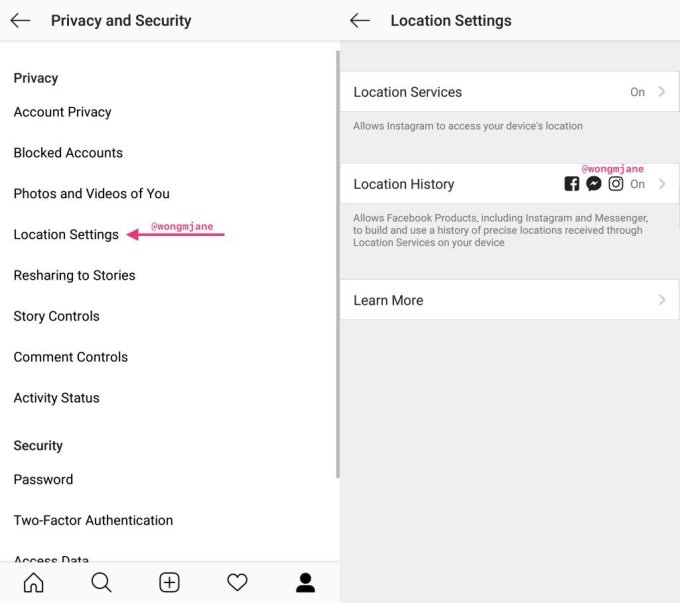
The screenshots come courtesy of mobile researcher and frequent TechCrunch tipster Jane Manchun Wong. Her prior finds like prototypes of Instagram Video Calling and Music Stickers have drawn “no comments” from Instagram but then were officially launched in the following months. That lends credence to the idea that Instagram is serious about Location History.
Located in the Privacy and Security settings, the Location History option “Allows Facebook Products, including Instagram and Messenger, to build and use a history of precise locations received through Location Services on your device.”

A ‘Learn More’ button provides additional info (emphasis mine):
“Location History is a setting that allows Facebook to build a history of precise locations received through Location Services on your device. When Location History is on, Facebook will periodically add your current precise location to your Location History even if you leave the app. You can turn off Location History at any time in your Location Settings on the app. When Location History is turned off, Facebook will stop adding new information to your Location History which you can view in your Location Settings. Facebook may still receive your most recent precise location so that you can, for example, post content that’s tagged with your location. Location History helps you explore what’s around you, get more relevant ads, and helps improve Facebook. Location History must be turned on for some location feature to work on Facebook, including Find Wi-Fi and Nearby Friends.”
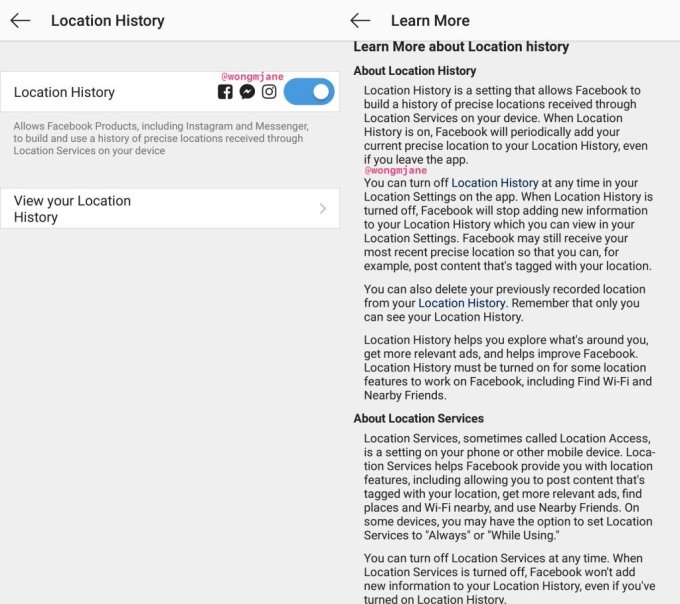
As part of a 2011 settlement with the FTC over privacy violations, Facebook agreed that “Material retroactive changes to the audience that can view the information users have previously shared on Facebook” must now be opt-in. But since Location History is never visible to other users and only deals with data Facebook sees, it’s exempt from that agreement and could be quietly added. Most users might never dig deep enough into their privacy settings to turn the opt-out feature off.
Delivering the exact history of where Instagram users went could assist Facebook with targeting them with local ads across its family of apps. If users are found to visit certain businesses, countries, neighborhoods, or schools, Facebook could use that data to infer which products they might want to buy and promote them. It could even show ads for restaurants or shops close to where users spend their days. Just yesterday, we reported that Facebook was testing a redesign of its Nearby Friends feature that replaces the list view of friends’ locations with a map. Pulling in Location History from Instagram could help keep that map up to date.
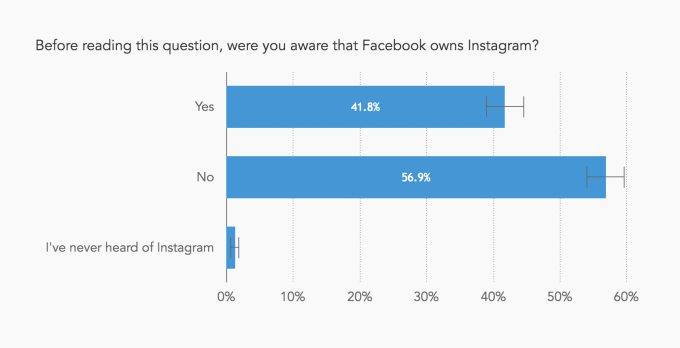
Sources tell TechCrunch that Instagram founders Kevin Systrom and Mike Krieger left the company following increasing tensions with Zuckerberg about dwindling autonomy of their app within the Facebook corporation. Systrom apparently clashed with Zuckerberg over how Instagram was supposed to contribute to Facebook success, especially as younger users began abandoning the older social network for the newer visual media app. Facebook is under pressure to keep up revenue growth despite it running out of News Feed ad inventory and users switching to Stories that advertisers are still acclimating to. Facebook is in heated competition with Google for last-mile local advertising and will take any advantage it can get.
Instagram has served as a life raft for Facebook’s brand this year amidst an onslaught of scandals including fake news, election interference, social media addiction, and most recently, a security breach that gave hackers the access tokens for 50 million users that could have let them take over their accounts. A survey of 1,153 US adults conducted in March 2018 found that 57 percent of them didn’t know Instagram was owned by Facebook. But if Facebook treats Instagram as a source of data and traffic it can strip mine, the negative perceptions associated with the parent could spill over onto the child.
Powered by WPeMatico
Between 2013 and last year, the number of boot camp schools tripled to more than 90 in the U.S. alone, according to Course Report, an outfit that tracks the industry. Some — including The Iron Yard and Dev Bootcamp — have since folded, unable to find enough eager recruits willing to pay top dollar to learn coding skills. (The average cost of a 14-week program last year was $11,400.)
At the same time, it has become apparent that when it comes to massive open online courses, a very high percentage of students don’t stay the course.
New York-based Codecademy, which began offering free coding courses at its outset, has managed to keep plugging away — and grow — despite these headwinds. In fact, the company today employs 85 people, up from 45 when we last sat down with co-founder and CEO Zach Sims in 2016. Its revenue is also up 65 percent year over year.
None of it has been a walk in the park, admits Sims, who dropped out of Columbia University in 2011 to start the company. “There’s been a ton of ups and downs,” he says, explaining that the company struggled for years with how to produce meaningful revenue before introducing two premium products in the last couple of years, both of which are affordable by design.
One of these is Codecademy Pro, meant to help users learn the fundamentals of coding, as well as develop a deeper knowledge (and receive certification from Codecademy) in up to 10 areas, including machine learning and data analysis. The cost is $20 per month, money that Pro users often see back in the form of a a $5,000 to $10,000 raise from their employer, insists Sims. He says the course “isn’t so much for those who are transitioning to full-time jobs but people who are learning skills to level up in their existing career.”
A second offering is Codecademy Pro Intensive, which is designed to immerse learners from six to 10 weeks (depending on the coursework) in either website development, programming or data science. Students follow a structured, detailed syllabus that’s divided into focused units to organize the learning experience, which is synchronous but collaborative. To wit, users are placed in a moderated Slack group and can chat with people who are learning the same materials at the same time. They also receive unlimited access to a pool of 200 mentors who work with Codecademy, some of them “graduates” of Codecademy themselves.
Sims declines to talk about what percentage of the 45 million people who’ve taken a Codecademy course has paid the company, but he notes that the “macro trends in the market are going our way. People still need to find jobs, and tech is still an important skill to get them there.” Indeed, according to Code.org, a nonprofit that seeks to expand computer science instruction in schools, there are more than 540,000 open computing jobs. At the same time, fewer than 50,000 computer science majors graduated from school last year.

Sims also stresses the importance to Codecademy of ensuring its offerings remain “free and low cost everywhere in the world.” Toward that end, the company is today rolling out its newest product, a mobile app that enables users to learn on the go, though it is accessible to paying customers only after a seven-day trial for everyone. (No credit card is required.)
The idea, says Sims: “Lots of people use mobile phones, and we should be letting them practice whenever and wherever they want. They end doing twice as many exercises if they can learn on the subway, then pick up where they left off on the desktop later.”
How much of an accelerant the app will be remains to be seen, but certainly, Codecademy’s approach — catering to people who can’t take or aren’t interesting in expensive offline programs — seems as relevant as ever as some of its competitors fade into the distance.
“When we first started,” says Sims, “the skills gap was just making itself evident. There were tons of tech reports about tech jobs and not a lot of people to fill them. A lot of boot camps and other options emerged to fill that vacuum because, at the time, colleges weren’t equipped to handle [the knowledge gap]. Plus, student debt continued to be an issue, which made [underprivileged] students particularly ill-prepared for the workforce.”
What has changed since then is, well, not much, argues Sims. He notes that aside from a glut of hyped offerings to come and go, people still need ways to adapt to rapid-fire technological change, and with college costs as high as they’ve ever been — prices have soared upwards of 200 percent over the last 20 years — they need affordable alternatives in particular.
If Codecademy requires more capital to continue providing as much, it isn’t saying. Asked about fundraising — Codecademy has raised $42.5 million to date, including from Union Square Ventures and Naspers — Sims says it isn’t talking currently with VCs. “We’re pretty capital efficient. We still have the majority of our last round (raised in 2016) in the bank. And we’ve been able to grow pretty sustainably.
“If we see opportunities to accelerate growth down the line,” he adds, “we’ll go raise it.”
Asked if it can see a day where it works more closely with enterprise customers that want to help employees burnish their skills, he says that’s a high likelihood, too. But “so far,” he says, “we’ve seen pretty good consumer growth. It kind of comes down to how many things can you focus on.”
Powered by WPeMatico
Of all the things to add to the blockchain, wine makes a lot of sense. Given the need for provenance for every grape and barrel, it’s clear that the ancient industry could use a way to track ingredients from farm to glass. VinX, an Israeli company founded by Jacob Ner-David, is ready to give it a try.
According to a release, the plan is to create a “token-based digital wine futures platform based on the Bordeaux futures model” that lets you track wine from end to end “at a cost bearable to the industry.”
Investment banker Gil Picovsky joined Ner-David to build out the service.
“I was relating to Gil my frustrations with the way most wine is sold, and I had some early thoughts around using blockchain and tokens to radically remake the wine industry,” said Ner-David. “Together Gil and I developed the core concepts of VinX, and started to actively devote ourselves full time to VinX in November 2017.”
“VinX is democratizing the capital structure of the wine industry by bringing consumers in direct contact with producers early in the wine-making cycle,” said Ner-David. “We are riding the wave of direct-to-consumer. In addition, because we are registering all wine futures as tokens on a blockchain, we are bringing a powerful validating force that will go a long way toward reducing fraud.”
Overstock’s investment arm, Medici Ventures, is not reporting how much cash they are dumping into VinX, but the company claims that “it is a seven-figure investment.”
The tool will help reduce the rate of fakery in winemaking. Experts estimate that 20 percent of all wine in the world is counterfeit. VinX will follow individual bottles from filling to drinking, ensuring a bottle is real.
Ner-David is also the co-founder of Jezreel Valley Winery, a boutique winery in Israel.
“We want to use modern technologies, including blockchain and tokening assets, in bringing consumers in direct contact with wineries around the world, humanizing the connection, and leaving more value in the hands of wineries and wine lovers,” he said.
Powered by WPeMatico